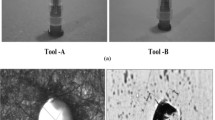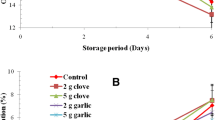Abstract
The mortality of Tribolium Castaneum (Herbst) can be increased by lower the oxygen level. With the above concept the effect of oxygen scavengers on the survival of Tribolium castaneum was assessed in the post-harvest engineering laboratory, UAS, GKVK, Bengaluru during 2017–18. The trial was conducted with four different packaging Pouches (Low-density polyethylene, High-density polyethylene and multi-layered pouches supplied by Swiss Pac and Ecotact) and Band sealers. Each pouch (25 × 18 cm) having a capacity of 1000 cc was filled with 850 g of foxtail millet. A single sachet of oxygen absorber (200 cc) and 20 pairs of one day old T. castaneum adults were released into each pouch. These pouches were placed in an incubator at a temperature of 30 ± 02 °C and 70 ± 5% relative humidity. Results revealed that in the Swiss Pac (0%) and Ecotact multi-layered (0%) pouches, which contained oxygen scavenger, the oxygen level was zero throughout the experimental period. The grain pouches containing oxygen scavenger had 100 per cent mortality of the beetle. Multi-layered pouches (Swiss Pac and Ecotact) proved to be the best packaging material for use of oxygen scavengers in the safe storage of foxtail millet grains. As the oxygen scavengers absorb oxygen completely within the pouches and maintains an oxygen-free atmosphere, thereby achieving the complete kill of the beetle.
Similar content being viewed by others
Data availability
The datasets supporting the conclusions of this article are included within the article.
References
Ahmed S, Gupta D, Srivastava AK (2013) Studies on development, quality evaluation and storage stability of weaning food prepared from multipurpose flour, papaya powder and milk powder. J Food Process Tech 4:1–5
Brody AL, Strupinsky EP, Kline LR (2001) Active packaging for food applications (1st ed.). Boca Raton, CRC Press
Chen Z, Schlipalius D, Opit G, Subramanyam B, Phillips TW (2015) Diagnostic molecular markers for phosphine resistance in US populations of Tribolium castaneum and Rhyzopertha dominica. PLoS ONE 10(3):e0121343. https://doi.org/10.1371/journal.pone.0121343
Chiappini E, Molinari P, Cravedi P (2009) Mortality of Tribolium confusum J. du Val (Coleoptera: Tenebrionidae) in controlled atmospheres at different oxygen percentages. J Stored Prod Res 45(1):10–13
Conyers ST, Bell CH (2007) A novel use of modified atmospheres: storage insect population control. J Stored Prod Res 43(4):367–374. https://doi.org/10.1016/j.jspr.2006.09.003
Emami K, Valizadegan O, Aramideh S (2016) Studies on respiratory toxicity of acetone and carbon dioxide on red flour beetle Tribolium castaneum (Herbst). Interaction 5:14–82
Hogan SA, Kerry JP (2008) Smart packaging of meat and poultry products. In: Kerry VJ, Butler P. (Eds.) Smart packaging technologies for fast moving consumer goods. John Wiley & Sons Ltd, West Sussex, England 33–59
Kitinoja L, Gorny JR (1999) Postharvest technology for small-scale produce marketers: economic opportunities, quality and food safety. Postharvest technology for small-scale produce marketers: economic opportunities, quality and food safety 21
Lloyd MA, Hess SJ, Drake MA (2009) Effect of nitrogen flushing and storage temperature on flavour and shelf-life of whole milk powder. J Dairy Sci 92:2409–2422. https://doi.org/10.3168/jds.2008-1714
Miltz J, Perry M (1995) Evaluation of the performance of iron-based oxygen scavengers, with comments on their optimal applications. Packag Technol Sci 18:21–27. https://doi.org/10.1002/pts.671
Nakakita H, Kawashima K (1994) A new method to control stored product insects using carbon dioxide with high pressure followed by sudden pressure loss. In: Stored product protection, proceedings of the 6th international working conference on stored-product protection, Canberra, Australia, 17–23
Navarro S (1978) The effects of low oxygen tensions on three stored-product insect pests. Phytoparasitica 6(2):51–58
Silas TAR Kajuna (2001) MILLET: Post-harvest Operations. Food and agriculture organization. http://www.fao.org/fileadmin/user_upload/inpho/docs/Post_Harvest_Compendium-MILLET.pdf. Accessed 26 September 2020
Vachanth MC, Subbu Rathinam KM, Preethi R, Loganathan M (2010) Controlled atmosphere storage technique for safe storage of processed little millet. Acad J Entomol 3(1):12–14
White ND, Jayas DS (2003) Controlled atmosphere storage of grain. Handbook of postharvest technology. Cereals, fruits, vegetables, tea, and spices, 235–251
Acknowledgements
The authors are grateful to Post Harvest Engineering Technology (PHET), UAS, G.K.V.K., for providing the required facilities carry out the experiment.
Author information
Authors and Affiliations
Corresponding author
Additional information
Publisher's Note
Springer Nature remains neutral with regard to jurisdictional claims in published maps and institutional affiliations.
Rights and permissions
About this article
Cite this article
Divija, S.D., Kishor Kumar, H.D. & Subramanya, S. Oxygen scavenger: promising tool for the management of Tribolium castaneum (Herbst) in small millet rice. Int J Trop Insect Sci 42, 1175–1180 (2022). https://doi.org/10.1007/s42690-021-00633-1
Received:
Accepted:
Published:
Issue Date:
DOI: https://doi.org/10.1007/s42690-021-00633-1




